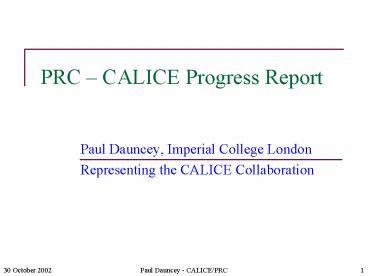PRC CALICE Progress Report PowerPoint PPT Presentation
Title: PRC CALICE Progress Report
1
PRC CALICE Progress Report
- Paul Dauncey, Imperial College London
- Representing the CALICE Collaboration
2
CALICE overview
- CALICE is studying LC ECAL and HCAL as an
integrated system - Technical feasibility of detectors
- Simulation verification of prototype with real
data - LC physics performance studies for jet energy
reconstruction - CALICE continues to attract new collaborators
- Currently 138 physicists, 24 institutes, 8
countries, all regions - New collaborators allow the project scope to
increase too - Silicon-Tungsten ECAL
- Tile HCAL scintillating tiles with analogue
readout - Fine-grained HCAL with digital readout several
options - RPCs, GEMs, small scintillating tiles
- Aim to have information for LC calorimetry TDR by
mid 2006 - Driven by possible LC decision in 2005
3
ECAL mechanics and silicon progress
Silicon wafer (Prague) design 6?6 diodes/wafer.
29 good wafers (out of 30) so far. Careful design
of inter-pad regions needed to minimise dead
space.
First carbon fibre mechanical structure (France)
and insert for prototype. Tungsten plates have
thickness and density within tolerance carbon
fibre structure show good mechanical behaviour.
1.0 mm
4
ECAL electronics
Very front end chip (Orsay) with 18 channels,
CR-RC shaper and multiplexer. Prototype back from
fabrication Sept currently under test. PCB to
hold chips and silicon wafers under design,
production in 2003.
Custom-built VME readout board (UK) may also be
used for HCAL readout. Aim for 1kHz peak rate.
Under design, with first prototype mid 2003.
5
Tile HCAL tile-fibre developments
Detailed study done of many combinations of
scintillating tile, wavelength-shifting fibres
and their mechanical coupling (DESY, Russia,
Prague) detailed write-up available from
V.Korbel.
- Example of tile-fibre geometry dependence varies
from 9 to 25 p.e./MIP
6
Tile HCAL photodiodes and electronics
Similarly detailed investigation of available
photodetectors with 5?5 cm2 scintillator tiles.
MIP peaks clearly separated from pedestals.
- All tested in beam with satisfactory performance
- None yet usable in high field
- Several will be used in prototype to gain
operation experience
MEPHI, Si-PM, 1?1 mm2 pixel
Hamamatsu, multianode PM, 5?5 mm2 pixel
Hamamatsu,APD, 5?5 mm2
Hamamatsu,APD-array,1?1 mm2 pixel
7
Digital HCAL options
- Three digital HCAL options now being actively
considered - RPCs (Russia, Korea, US)
- Scintillating tiles (US)
- GEMs (US)
- Latter two possible due to new groups joining
collaboration - More US groups asking to join these efforts in
future - Front-end electronics developments (France/Korea)
- Simple Q-V conditioner circuit feeding FPGA
directly - Could be used for any/all options
- Back-end electronics may be common to ECAL/HCAL
- Reusing ECAL readout boards (UK)
- Leads to common DAQ system
8
Digital HCAL RPCs
A lot of HEP experience cheap easy to use,
flexible pad size/shape.
Glass resistive plates, anode pads outside gas
gap gives superior performance with e 98
First custom RPC plane early 2003, prototype mid
2004
Clear signals seen in both avalanche and streamer
mode
9
Digital HCAL scintillating tiles
Small scintillating tiles with wavelength-shifting
fibre (NICADD)
Hexagonal pad 2 cm/side spray paint (not wrap)
external surface for reflectivity
Sigma groove also being studied
- Ten layer module in 2003
- Prototype by late 2004 or 2005
Good MIP separation seen
10
Digital HCAL GEMs
GEM development (UTA) using GEM foils from CERN
GEM foil (CERN) micrograph hole size 75mm
Prototype 10?10 pad array. Each pad 1?1 cm2. Aim
to install several layers in prototype in 2005.
11
Software simulation comparisons
Need to verify simulation before optimising
calorimeter design significant disagreements
between GEANT3/4, particularly p/n (UK)
- Before beam test data
- Compare GEANT3, GEANT4, Fluka
- Determine most sensitive variables to vary in
beam - Using beam test data
- Tune simulation parameters to optimise
description - Determine best simulation to use
12
Software reconstruction and EFLOW
REPLIC reconstruction program for calorimeters
using full reconstruction (France)
Charged pads
Good reconstruction of number of photons/event
Photons multiplicity/event
FANAL
photons
Example of clean separation with narrow showers
in silicon-tungsten realistic EFA tests now
feasible.
13
Beam test preparations
Beam test with both ECAL and HCAL
- Test all HCAL options
- Same Fe plates and mechanical structure
- Data taking in 2004/5
- O(102) configurations (HCAL ? beam energies ?
particle types ? preshower ? incident angle ) - O(106) events per configuration
- O(1TByte) of data total
14
Summary
- Great amount of progress in many areas
- New collaborators broadened scope of project
- ECAL mechanical and electrical, all on schedule
- Tile HCAL large optimisation program nearing
completion - Digital HCAL new options starting up, sharing
common mechanics for beam test prototype
installation - Software simulation comparisons in place and
mature reconstruction package available - Beam test is an essential part of the CALICE work
- Technology feasibility, operational experience,
simulation verification all needed to verify
basic calorimetry concept - We invite the PRC to recognise the importance of
this part of the program

